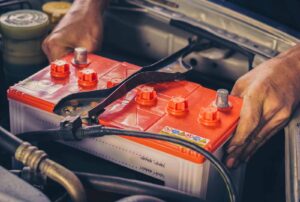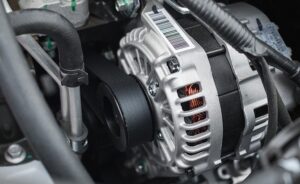Have you ever hopped in your car one cold morning, turned the key to start your vehicle, to soon find out your car won’t start? You try once more and get the same result. The timing is always the worst possible and now you need to get your vehicle towed or call a company like AAA for a jump start.
There’s almost nothing worse than this scenario when it comes to your vehicle & living in cold temperatures. Noone likes being stranded in a parking lot with a car that won’t start. So, We’ve put together a video and this blog post to help prevent this situation from arising. Here are some of the top reasons why your vehicle may not be starting and some warning signs to look out for.
Why isn’t my car starting?
As the frigid winter months descend upon New England, vehicle owners face a unique set of challenges, especially when it comes to their charging and starting systems. With temperatures plummeting to zero degrees Fahrenheit and lower, the strain on a vehicle’s charging and starting components becomes critical. The battery, a vital power source, must work harder in the cold, providing the necessary energy to start the engine despite the decrease in temperature. The alternator, on the other hand, plays a crucial role in recharging the battery and providing power to the vehicle’s electrical systems. Meanwhile, the starter is responsible for initiating the engine’s combustion process, requiring extra power in low temperatures. Ensuring these components are in optimal condition is essential for a vehicle’s reliability during the harsh winter conditions of New England.
Battery
Your battery serves as a crucial component, providing the initial power needed to start the engine and also supplying electricity to various systems when the engine is off. During snowy months in New England, the battery’s importance is amplified as it must overcome increased resistance due to the cold, while still delivering the necessary power to start the engine reliably.

Typically, a car battery can last anywhere from three to five years, but this lifespan can be affected by factors such as temperature extremes, usage patterns, and maintenance. Regular inspections and testing, especially before the onset of winter, can help ensure that your battery is in optimal condition to tackle the challenges of the cold season.
Several signs indicate that your vehicle’s battery is reaching the end of its lifespan and may need replacement. Here are some common indicators to watch out for:
- Slow Engine Crank: When you start your vehicle, if you notice the engine cranking slowly or taking longer than usual to start, it could be a sign of a weak battery.
- Dimming Lights: The lights on your dashboard or interior lights may appear dimmer than usual when the battery is weak. This dimming can also extend to your headlights.
- Electrical Issues: If you experience electrical problems such as power windows moving slower than normal or the radio and other electronics behaving erratically, it could indicate a failing battery.
- Check Engine Light: Sometimes, a failing battery can trigger the check engine light on your dashboard. While this light can indicate various issues, a weak battery is one possibility.
- Sulfur Smell: If you detect a rotten egg or sulfur smell around the battery, it could indicate a leak or other internal issues that require immediate attention.
- Old Age: If your battery is more than three years old, it’s a good idea to have it tested regularly, especially before winter, as cold temperatures can exacerbate battery issues.
- Previous Jump Starts: If you’ve recently needed to jump-start your vehicle multiple times, it’s a clear sign that your battery is struggling and may need replacement.
If you notice any of these signs, it’s wise to have your battery tested by a professional to determine if it needs replacement.
Battery Cables and Terminals
Battery cables and terminals play a critical role when it comes to your vehicle starting or not. The battery cables are heavy-duty cables that connect the battery to the vehicle’s electrical system, while the terminals are the points where the cables are attached to the battery.

These components are essential for transmitting electrical power from the battery to the rest of the vehicle, including the starter, alternator, and other electrical components. It’s important to make sure the terminals and the cables are not corroded as shown in this image. If you notice similar levels of corrosion on your terminals we would recommend bringing your vehicle to your trusted Auto repair shop.
Preventative maintenance on battery cables and terminals is crucial for several reasons:
- Electrical Conductivity: Over time, corrosion can build up on the battery terminals and cables, reducing their ability to conduct electricity efficiently. This can lead to starting problems, electrical malfunctions, and even damage to other electrical components.
- Secure Connections: Loose or corroded terminals can result in poor connections, which can cause intermittent electrical issues or complete electrical failure. Regular maintenance ensures that the connections are tight and secure, minimizing the risk of electrical problems.
- Battery Life: Properly maintained cables and terminals help ensure that the battery operates at its full potential. This can prolong the battery’s lifespan by preventing unnecessary strain on the electrical system.
- Safety: Corroded or damaged cables and terminals can pose a safety hazard due to the risk of electrical shorts or fires. Routine maintenance helps identify and address any potential safety issues before they become serious problems.
To maintain battery cables and terminals:
- Regular Inspection: Inspect the cables and terminals for signs of corrosion, damage, or looseness. Clean any corrosion
- Tighten Connections: Ensure that the connections are tight and secure. Loose connections can lead to electrical problems and should be addressed promptly.
- Protective Coating: Consider applying a protective coating or grease to the terminals to prevent future corrosion.
Alternator
The alternator is responsible for converting mechanical energy from the engine into electrical energy. This electrical energy is used to recharge the battery and power the vehicle’s electrical systems while the engine is running. Due to its crucial role, a malfunctioning alternator can lead to a range of electrical issues in your vehicle and can even cause the battery to drain, leading to starting problems. Typically, an alternator can last anywhere from 80,000 to 150,000 miles, but its lifespan can vary depending on factors such as driving conditions, vehicle usage, and maintenance.
Here are several signs that your alternator is failing or malfunctioning:
- Dimming or Flickering Lights: If you notice that your headlights, interior lights, or dashboard lights are dimming or flickering, it could be a sign that the alternator is not providing enough power to the electrical components.
- Warning Lights: The battery-shaped warning light on your dashboard may illuminate, indicating a problem with the charging system. This light typically looks like a battery symbol and may also say “ALT” or “GEN.”
- Weak or Dead Battery: A failing alternator can lead to a weak or dead battery. If you find yourself needing to jump-start your vehicle frequently, it could be due to a problem with the alternator not properly charging the battery.
- Strange Noises: A malfunctioning alternator may produce unusual noises, such as a whining or grinding sound. These noises can indicate issues with the alternator bearings or other internal components.
- Electrical Issues: If you experience electrical problems such as power windows or seats not working correctly, or the radio or other electronics behaving erratically, it could be due to a failing alternator.
- Burning Smell: A burning rubber smell near the engine could indicate a slipping belt that connects the alternator to the engine, which can lead to alternator failure if not addressed.
- Stalling or Difficulty Starting: A failing alternator can cause intermittent stalling or difficulty starting the vehicle, especially when combined with other electrical symptoms.
The signs of a failing alternator can resemble those of a bad battery. However, a definitive indicator that your alternator is failing is when your car dies shortly after removing the jumper cables after jump starting your dead car.

Starter
The starter is responsible for initiating the engine’s combustion process. When you turn the key or press the start button, the starter motor engages with the engine’s flywheel or flex plate, causing the engine to crank and start. This process requires a significant amount of electrical power to overcome the engine’s compression and get it running. In cold winter conditions in New England, the starter faces additional challenges due to the increased viscosity of engine oil and higher resistance in the engine, making a reliable starter even more critical. Generally, a starter motor can last anywhere from 50,000 to 100,000 miles, but its lifespan can vary depending on factors such as driving conditions, vehicle usage, and maintenance (just like the battery and alternator component).
Several signs can indicate that your vehicle’s starter is failing and may need to be replaced. Here are some common signs to watch out for:
- Engine Cranks Slowly or Fails to Crank: If you notice that the engine cranks slowly when you try to start your vehicle, or if it fails to crank at all despite a charged battery, it could be a sign of a faulty starter.
- Clicking Noise: When you attempt to start your vehicle, a rapid clicking noise coming from the starter or the starter solenoid could indicate a problem. This sound often occurs when the starter motor is receiving power but failing to engage with the engine.
- Freewheeling: Freewheeling occurs when you hear a whirring noise without the engine cranking. This can happen if the starter gear isn’t engaging properly with the engine’s flywheel or flex plate.
- Electrical Issues: A failing starter can cause electrical issues such as flickering lights or other electrical components behaving erratically when you try to start the vehicle.
- Burning Smell: A burning smell, especially when attempting to start the vehicle, could indicate that the starter motor is overheating due to electrical problems or mechanical issues.
- Starter Solenoid Issues: Problems with the starter solenoid, which is responsible for engaging the starter motor with the engine, can also manifest as starting problems. This can include a single loud click when you turn the key, indicating that the solenoid is engaging but the starter motor is not.
If you notice any of these signs, it’s essential to have your vehicle inspected by a qualified mechanic to diagnose the issue accurately and determine if the starter needs to be replaced. Ignoring starter problems can lead to more significant issues and potential vehicle breakdowns, especially during the challenging winter conditions in New England.
Regular maintenance and inspection of these components is essential for ensuring reliable vehicle performance. At Auto Care Plus, we offer a comprehensive Terminal Battery Service that includes thorough testing of all connections, checks the charge of your battery, and the removal of any corrosion, helping to keep your vehicle’s electrical system in top condition. Follow these tips to avoid no-start driving experiences, even in the harshest of winter conditions.
Happy Driving!
0 Comments